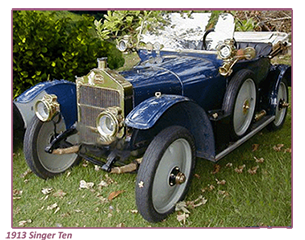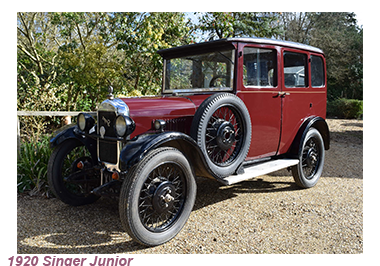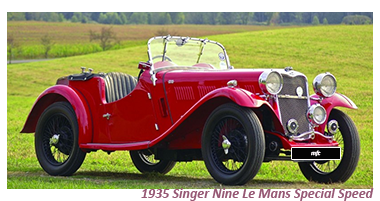
Singer of Coventry, founded by the renowned cycle-maker George Singer, took their first steps in the world of automotive transport when they began producing simple pedal cycles way back in 1876.
 The next stage in the Singer company's evolvement was motorcycle production, advanced through being granted the marketing rights for the revolutionary Perks and Birch motorised wheel.
The next stage in the Singer company's evolvement was motorcycle production, advanced through being granted the marketing rights for the revolutionary Perks and Birch motorised wheel.
 This breakthrough paved the way for Singer to become among the leading producers of front wheel powered motorised bicycles and tricycles in the United Kingdom at the turn of the 20th century.
Having developed a strong client base Singer finally began to produce petrol driven three-wheeled motor cars in 1905.
These cars were produced under license from the larger and longer established Lea Francis automobile manufacturing company, also based in Coventry.
This breakthrough paved the way for Singer to become among the leading producers of front wheel powered motorised bicycles and tricycles in the United Kingdom at the turn of the 20th century.
Having developed a strong client base Singer finally began to produce petrol driven three-wheeled motor cars in 1905.
These cars were produced under license from the larger and longer established Lea Francis automobile manufacturing company, also based in Coventry.
![]()

 Before the outbreak of the First World War stopped them in their tracks, Singer were moving forward all time, enjoying considerable success with their Model Ten , which was claimed to be the first compact car produced in the UK, , affordable, reliable, inexpensive to buy and run.
Before the outbreak of the First World War stopped them in their tracks, Singer were moving forward all time, enjoying considerable success with their Model Ten , which was claimed to be the first compact car produced in the UK, , affordable, reliable, inexpensive to buy and run.
At the same time, Singer were earning themselves a reputation as innovators in production technology, among the first to introduce independent front suspensions and fluid-coupling transmissions among other developments.
Things continued to go well for Singer and by the end of the Nineteen Twenties, had grown to become among the U.K.'s leading car makers, both regarding innovation and production, at one time reaching the level of the fourth largest auto producer in the country.
![]()

The Thirties were to prove much more challenging for the company, due to the major depression that was taking its toll on global trade.
Despite the downturn, Singer held on through the decade, although they had little money to invest in updating equipment and technologies at their factories in the Midlands cities of Birmingham and Coventry. Raising their head again after the hostilities in 1945, Singer launched their post-war production program with the SM 1500/Hunter saloon.
The Singer SM 1500/Hunter proved to be a steady seller, although not successful enough or profitable enough to push the factory forward, especiallywhen it came to setting aside funds for much-needed development capital.
Raising their head again after the hostilities in 1945, Singer launched their post-war production program with the SM 1500/Hunter saloon.
The Singer SM 1500/Hunter proved to be a steady seller, although not successful enough or profitable enough to push the factory forward, especiallywhen it came to setting aside funds for much-needed development capital.
 This situation meant that by the mid-Fifties, Singers found themselves in a state of stagnation, with barely enough money to develop new model ranges to keep up with the opposition, especially the big guns at BMC, Ford, and Vauxhall.
Despite having survived the Second World War, in truth Singer never fully recovered from the depression of the 1930s, and also through the Fifties was fighting a losing battle to maintain their liquidity.
This situation meant that by the mid-Fifties, Singers found themselves in a state of stagnation, with barely enough money to develop new model ranges to keep up with the opposition, especially the big guns at BMC, Ford, and Vauxhall.
Despite having survived the Second World War, in truth Singer never fully recovered from the depression of the 1930s, and also through the Fifties was fighting a losing battle to maintain their liquidity.
Take me back to the home page.


